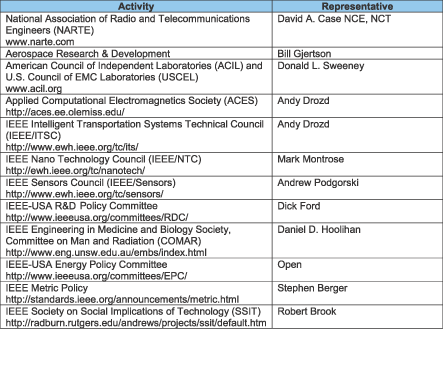As of the fall of 2002, I took over the chairmanship of the Representative
Advisory Committee from Dave Case. He has done a good job in getting
the group organized and focused. Dave has found himself with a
new world of responsibilities, including visiting the “Old
World” of Austria at the World Radio Congress.
My first interest as chair is to get clear what is who and who
is what. The table at right gives the full title of the activities
represented on the committee, the web link and the current representative.
This list demonstrates the purpose of the RAC, which is to bring
together groups that have technical interests related to the mission
of the EMC Society. We have an opening for a person who is working
with the Energy Policy Committee and the Society on Social Implications
of Technology.
Now as to the activities of these groups, I have received the
following status of what is going on.
Dave Case reports that the NARTE board met in May with a focus
on the telecom certification program. They are also looking at
updating telecom and wireless tests and programs.
Donald L. Sweeney reports that the USCEL has become a sub-committee
of ACIL’s EMC committee. This has enabled them to combine
many of the presentations previously given at separate meetings,
to be covered only once for those who have common membership.
ACIL – EMC – Committee-ELWAG issued an improved process
for auditors to audit EMC laboratories. This list is now in use
and NVLAP will be listing new accreditations using this process
about June 15, 2003. The program took years to implement but will
save many thousands of dollars due to redundant evaluations. We
believe this will save manufacturers, laboratories and auditors
a lot of time and money.

Andy Drozd reported in the last issue of the Newsletter with
an extensive article on ACES. Their next conference will be in
the spring of 2004, hopefully in Syracuse, New York. With regard
to ITSC, the EMCS is not formally funding their activities as
a result of a BOD vote, but we will be keeping in touch. They
have their next symposium planned for Shanghai, China on October
12-15, 2003.
Mark Montrose reports that he is very active and attending the
NTC Excom meeting in April. The IEEE Nanotechnology Council is
part of Division I, Circuits and Devices, and is made up of 19
member Societies. The NTC conference and yearly ADCOM meeting
was held the week of August 10 at Wescon, San Francisco. EMCS
has provided coordination of the two units by issuing a Call for
Papers for a special issue of the Transactions on EMC involving
Nanotechnology.
Andrew Podgorski reports that the Sensors Council will have its
second IEEE International Conference on Sensors on October 22-24,
2003 at the Sheraton Centre Hotel, in Toronto, Canada. The Sensors
Council has 26 member Societies. This year’s program consists
of more than 300 oral and poster presentations from 35 countries.
The program will again include sessions on theory, design and
application of sensors, and there will be special sessions focusing
on a variety of sensors topics.
Dick Ford reports that the committee has consolidated the efforts
of the other R&D committees into one single group with a common
focus. The overall objective of the R&D Policy Committee is
to develop and disseminate positions on engineering and defense
research and development policies and programs in the United States
within the scope of, or affecting, IEEE’s technical expertise.
Dan Hoolihan reports that the 25th Annual International Conference
of the IEEE Engineering in Medicine and Biology Society will be
held in Cancun, Mexico from the 17th to the 21st of September
2003; please see his article on COMAR in this issue of the Newsletter
for more details.
At the RAC meeting in August 2003, Ralph Wyndrum gave an overview
of the IEEE-USA 2003 Technical Policy Activities. The bottom line
to his presentation is that they are in need of members who are
interested in presenting technically important and relevant information
from IEEE-USA to the public, Congress, and the executive branch
of the federal government, and similarly to state governments
when appropriate. Many of the open positions on our committee
relate to IEEE-USA. The most relevant opening is on the Committee
on Communications and Information Policy, where in 2003 they are
tasked to provide insight into designing and measuring secure
IT products and services, broadband deployment, spam and spectrum
management. To join the committees as a Resource/Corresponding
Member, go to https://www.ieeeusa.org/committees/.
I found the following from the web to share with Newsletter readers.
IEEE Policy 9.20, which calls for measured and calculated values
of quantities to be expressed in metric units in IEEE publications,
following the detailed guidance for SI-based metric practice given
in IEEE Standard 268. The specific requirement for Stage III is
that after 1 January 2000, proposed new standards and revised
standards submitted for approval shall use metric units exclusively
in the normative portions of the standard. Inch-pound data may
be included, if necessary, in footnotes or annexes that are informative
only.
The Energy committee, the Technology Policy Council, and the IEEE-USA
Board have debated assorted proposed foci and concluded that the
priority themes will include:
 Representative
Advisory Committee (RAC): What’s Going On?
Representative
Advisory Committee (RAC): What’s Going On? Geoslavery
Geoslavery